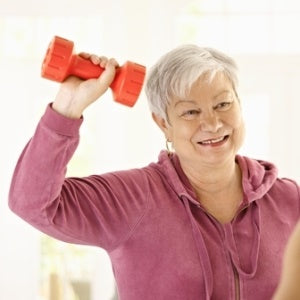For obese older persons, reducing calories by 250 per day with moderate activity outperformed exercise alone. According to new research published today in the American Heart Association's flagship journal Circulation, combining aerobic exercise with a moderate reduction in daily calories improved aortic stiffness (a measure of vascular health, which impacts cardiovascular disease).
Healthy eating habits and frequent exercise may help reduce aortic stiffness as we age. Although aerobic exercise generally benefits aorta structure and function, that alone may not be enough to reduce aortic stiffness in obese older persons.
"This is the first study to compare the effects of aerobic exercise training with and without calorie restriction on aortic stiffness," said Tina E. Brinkley, Ph.D., lead author and associate professor of gerontology and geriatric medicine at the Sticht Center for Healthy Aging. "We wanted to see if calorie restriction combined with aerobic exercise improved vascular health in obese older persons."
This study recruited 160 sedentary people aged 65-79 with obesity (BMI 30-45 kg/m2). The participants were 69 years old on average, 74% female, and 73% white. For 20 weeks, participants were randomized to one of three groups: Exercise only with their regular diet; exercise plus moderate calorie restriction (about 250 calories/day) and exercise plus more rigorous calorie restriction (roughly 600 calories/day.)
Pre-made lunches and dinners with less than 30% fat and at least 0.8 grams protein per kg of ideal body weight were given to the calorie-restricted groups; they produced their own breakfasts from a dietitian-approved menu. During the 20-week study, everyone in the study underwent supervised aerobic exercise training four days per week at the Wake Forest Geriatric Research Center.
The aortic arch pulse wave velocity (PWV) (the speed at which blood travels through the aorta) and distensibility (the aorta's ability to expand and contract) were measured using cardiovascular magnetic resonance imaging. Aortas with higher PWV and lesser distensibility have aortic stiffness.
Aortic stiffness improved significantly with weight reduction of approximately 10% of total body weight or about 20 pounds over the five-month research period, but only in the exercise with moderate calorie restriction group.
Other findings:
The exercise with moderate calorie restriction group exhibited 21% more distensibility and 8% less PWV.
These changes were greater in the calorie-restricted groups than in the exercise-only group.
Weight loss was similar amongst the calorie-restricted groups despite the rigorous calorie restriction group having nearly two times less calories (26.7 vs. 14.2%).
"Our findings suggest that increasing aerobic activity and decreasing daily calorie intake may help reduce aortic stiffness and enhance overall vascular health," Brinkley said. "However, the most calorie restricted group showed no improvement in aortic stiffness, despite identical weight and blood pressure reductions as the moderate calorie restricted group."
Brinkley said: "It appears that combining exercise with modest calorie restriction — rather than more intense calorie restriction or no calorie restriction — enhances vascular health benefits while simultaneously maximizing weight loss, body composition, and fat distribution. That higher-intensity calorie restriction may not be essential or indicated for older obese persons has crucial implications for weight management recommendations."
Source: Tina E. Brinkley, Iris Leng, Margie J. Bailey, Denise K. Houston, Christina E. Hugenschmidt, Barbara J. Nicklas, W. Gregory Hundley. Effects of Exercise and Weight Loss on Proximal Aortic Stiffness in Older Adults With Obesity. Circulation, 2021; DOI: 10.1161/CIRCULATIONAHA.120.051943



